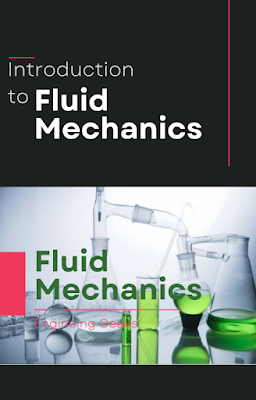Introduction to Fluid Mechanics
Mechanics is the study of forces and motions,
and therefore fluid mechanics is the study of forces and motions in fluids, but
what does the word "fluid" mean? We can all cite clear examples of
those substances (fluids) such as: air, water, gasoline, lubricating oil and
milk, and we can also mention some examples that are clearly not fluids such
as: iron, diamond, rubber and paper that are classified as they are considered
solids, but other forms of matter such as jelly, peanut butter, toothpaste, tar
and baked goods have intermediate properties between liquids and solids.
And to decide what we mean by the word fluid, we must first
consider the idea of shear stress, since it is easier for us not to touch on
tensile stress or compressive stress, but first what is stress and what are its
three types?
In Figure (a) we notice that the rope lifts
an object that affects its weight with a force that pulls the rope down, and
since the stress is the ratio between the effective force and the area that the
force affects (note that the force acts perpendicular to the area), the stress
in the rope It is the tensile forces acting due to the weight divided by the
area of the rope cross section and it is called tensile stress.
In Figure (b) we find that a steel iron column lifts a body where the weight of the body
affects a force that presses on the column. The stress in this case is the
compressive forces resulting from the weight of the body Divided by the
cross-sectional area of the column bearing it and the perpendicular to it, it
is called compressive stress. It is called shear stress.
In our attempt to determine the difference
between solids and fluids, we can say that solids are materials that have the
ability to resist large shear stresses, because when exposed to shear stress,
solid materials tend to form internal shear stress that resists the external
force exposed to it until it reaches a state of equilibrium (stops moving).
As for fluids, they cannot resist shear stresses,
even if they are small stresses. As for materials intermediate between solids
and fluids, they can resist small stresses, but they cannot resist large
stresses, meaning that the difference between materials and some of them is the
amount of their resistance to shear stress, but at very high shear stresses,
solid iron can move like fluids because of the occurrence of deformation
Durable in shape (plastic deformation).
What is the benefit of
studying fluid mechanics?!
The problems that we will face when we study fluid mechanics in general are no different from those we faced previously while studying mechanics (mechanics of solids), as well as with thermodynamics, meaning that by following the same problem-solving methodology, we can solve the problems we will face during our study of fluid mechanics, and therefore When solving a problem involving fluid flow or the movement of objects through fluids, we will use a combination of mechanics and thermodynamics problem solving methods, in addition to this method is applicable to solving hydraulic problems (dams, canals and rivers), and with some minor modifications related problems can be solved It can also be applied to problems related to chemical engineering such as fluid flow in chemical reactors or distillation towers or the extrusion of plastics during their formation.
To understand the importance of study of fluid mechanics, let's take a closer look at the most important fluids in our lives. We breathe air, drink water and other fluids, burn fuel to heat our homes and drive our cars. Even our bodies contain a fluid inside, which is blood, without an accurate understanding of the behavior of fluids. We will only be able to understand limited things from the world around us.
Fluid mechanics applications
are divided into:
Hydraulics: It is concerned with studying the flow of water in rivers, pipes, canals, pumps and turbines.
Aerodynamics: concerned with the study of air flow around installations, aircraft, engines and projectiles.
Meteorology: concerned with the study of weather and climate.
Particle dynamics: concerned with the study of the movement of fluids around particles and the forces of attraction between particles and fluids.
Hydrology: concerned with the study of the flow of water and the pollutants transported by water in the earth.
Well mechanics: It is concerned with studying the flow of oil, gas and water in oil wells.
Flow of a heterogeneous mixture of fluids: as in oil wells, fuel injectors, combustion chambers and sprinklers.
Mixing several fluids: such as what happens in combustion reactions or in the case of material transfer in distillation towers.
Flow of high viscosity fluids: lubricants, plastics that are formed in injection molds, materials used in wire sheathing, volcanoes and continental drift.
Basic ideas in fluid mechanics
Fluid mechanics is fundamentally dependent on:
The principle of conservation of mass
The first law of thermodynamics, which concerns the conservation of energy
The second law of thermodynamics
Newton's law of motion, which is summarized in the relationship (F = ma)
These principles and laws are a generalization of experimental and laboratory data that cannot be deduced from the other or from any of the previously mentioned principles and none of them can be proven mathematically, and the validity of each of them lies in their ability to correctly predict the results of any experiment, and when calculating the value of a power or Speed While solving a problem, these principles and laws are used in addition to the measured physical properties values of the materials used directly, but this is only possible in the case of a simple fluid flow.
We can resort to laboratory tests, and it is
also possible by using the non-dimensional analysis technique - we will discuss
it in another article - to use the results of one of the experiments to predict
the results of different other experiments, meaning that accurate laboratory experiments
are of great importance in fluid mechanics, and with the development of
computers.
We can now solve a lot From the mathematical
problems using the methods that will be mentioned in later articles, and as
computers become faster and cheaper, it is possible that we will see other more
complex problems of fluid mechanics solved using computers, but in all cases
these results must be verified in my laboratory.
First we will discuss in our articles some
properties of fluids and some definitions, then we will apply Newton's law of
motion to static fluids - which is a simple special case - we will then touch
on the principle of conservation of mass and energy and their application to
important practical cases.
More complex than the previous ones, and then
we will repeat Formulating Newton's law of motion to put it in the form of a
momentum balance to be used in solving problems and discussing some of its
applications. Last but not least, what has been studied will be applied to the
high-velocity flow of gases, where we will observe various additional, very
important phenomena.
Later, other topics will be presented in an expanded manner
in fluid mechanics, but there are no new principles or ideas that will be
addressed, only special topics and methods will be discussed.
Liquids and Gases
Fluids are divided into two types of states of matter:
liquids and gases, they are similar in that they take the shape of the
container they contain (they do not have a fixed shape), but they differ at the
molecular level greatly, in liquids the molecules are close and interconnected
with each other with relatively large forces of attraction.
In gases, the
molecules are far from each other and the forces of attraction between them are
very weak, and these differences gradually decrease until the behavior of a
liquid and its vapor becomes identical at critical temperature and pressure,
and this difference in their behavior is evident when fluids expand.
Suppose that the piston shown in the figure is filled with a
fluid, if the fluid is a gas, it will expand easily and fill the extra space
resulting from pulling the piston up, because gases have the ability to expand
greatly, but if the fluid was a liquid and then the piston was pulled up, the
liquid It will expand very little and will not be able to fill this void.
What fills the space between the piston and the fluid?
Part of this liquid turns into a gaseous state as it evaporates, and this gas expands until it fills the resulting void. What happened at the molecular level can be explained by saying that the forces of attraction between the molecules of the liquid bind the molecules together within a distance and when those molecules overcome the forces of attraction, Released outside this range, it loses the behavior of a liquid and turns into a gaseous state.
Sources and references
1] Fluid Mechanics, Fundamentals and Applications, Y. A. Cengel, J. M. Cimbala, 2nd Ed., McGraw Hill, 2009.
[3] Fluid Mechanics for Chemical Engineers with Microfluidics and CFD, J. O.
Wilkes, 2nd Ed., Prentice Hall, 2005.





.jpg)
2 Comments
A good step to aware engineers about engineering
ReplyDeleteWaiting for a long time to read such topics
ReplyDelete